Introduction
Product Tour
Front
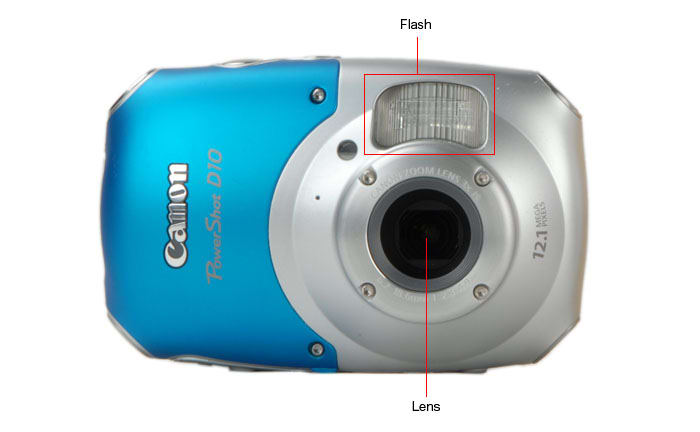
Back
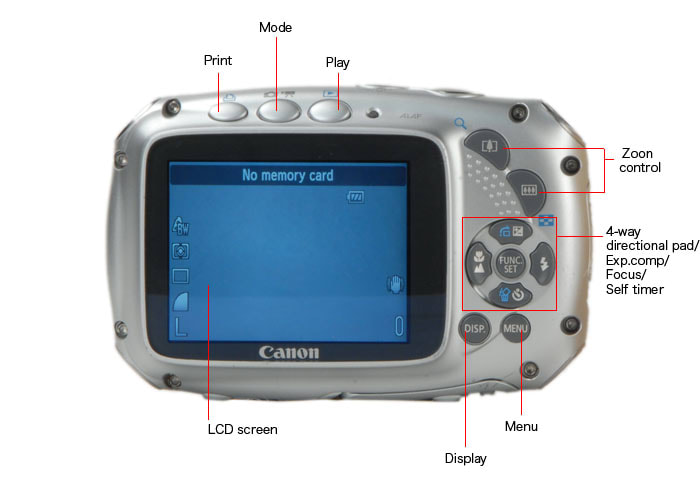
Sides
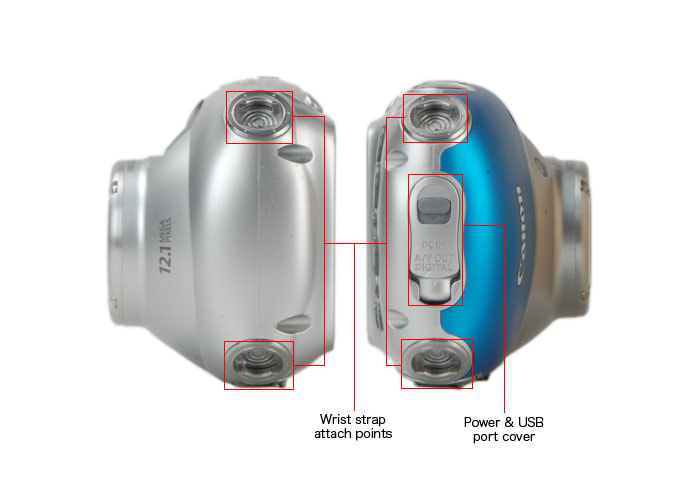
Bottom
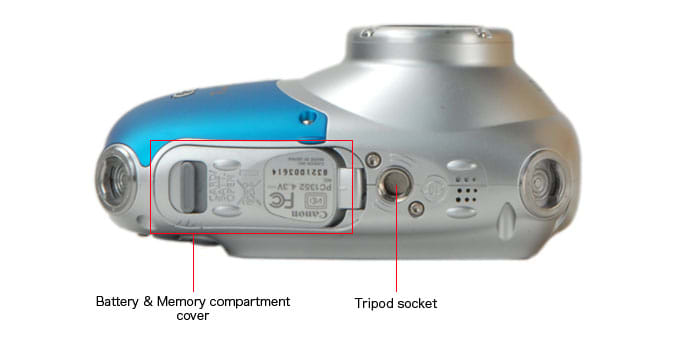
Top
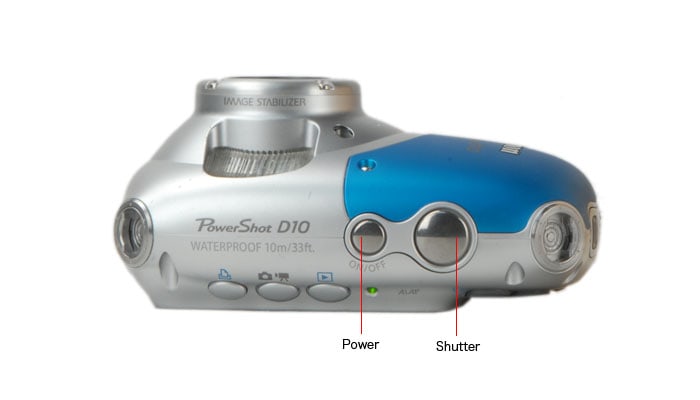
**Size Comparisons **
**In the Box **
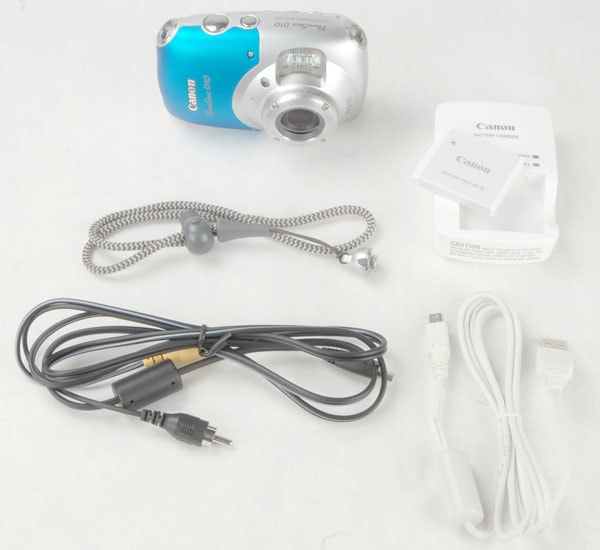
The contents of the Canon D10 box
• The camera
• CB-2LY charger
• NB-6L 1000 mAh battery
• Wrist strap
• USB cable
• A/V output cable
• Manuals (not shown)
• Software CD (not shown)
Color
**Color Accuracy ***(10.36) *
We were impressed by the color performance of the D10 in our tests: it captured accurate, bright colors in our tests. These tests involve shooting a color chart in precisely controlled conditions, and then measuring how accurately the camera captures the colors using the image analysis program Imatest. Click here for more on how we test color
As you can see from the examples below, the D10 did an excellent job with most of the colors, with the only real exception being that some colors were a little dull (such as the reds and blues) and one of the greens was a little off. But that's unlikely to be a huge problem when shooting everyday objects. The D10 has a range of color modes (see below), but we found that turning the color modes off gave the most accurate color.
Although the D10 did not do as well as some point and shoot cameras in this test, it did do better than all of our comparison underwater cameras, capturing more accurate colors than all of them.
NOTE: Because of the way computer monitors reproduce colors, the images above do not exactly match the originals found on the chart or in the captured images. The chart should be used to judge the relative color shift, not the absolute captured colors.
Color Modes*(5.00)*
Like most Canon cameras, the D10 offers a veritable smorgasbord of color modes under the name of My Color. You can set this to off, vivid, neutral, sepia, black & white, positive film, lighter skin tone, darker skin tone, vivid blue, vivid red, vivid green or a custom mode. In this custom mode, you can tweak the settings for contrast, sharpness, saturation, red, green, blue and skin tone, with 5 levels of each.
Noise
Noise*(8.33)*
The D10 did a very decent job of keeping the noise in images low. We did find that there was noise in all of our test images, though; even those shot at low ISO levels in good light had some noise, and this became more obvious as the ISO level was increased. However, the D10 did a decent job of reducing this noise, so images are still very usable at high ISO settings. Click here for more on how we test noise.
In our first test, we shoot our test chart at two light levels: 60 lux (about the same as most indoor lighting) and 3000 lux (about the same as daylight on a sunny day). We found that the noise levels in the pictures shot under darker conditions had lower noise, presumably because the camera was using a slower shutter speed, and did some stronger noise reduction processing. But on both tests, the noise level was acceptable.
In the chart below, we show the performance of the D10 against our comparison cameras, and here you can see that the D10 is a strong performer: the noise level is significantly lower than most other cameras across the ISO range.
Overall, the D10's noise performance is decent, but not spectacular. There is a significant amount of noise in the images at all ISO levels, but it remains lower than most other cameras, especially at the higher ISO settings. That's more about the poor performance of many other cameras than the D10, though.To see examples of the noise in images captured by the D10, see the table below.
ISO*(6.00)*
The D10 has an ISO range of 80 up to 1600 at full resolution. This can be increased to 3200 by using the ISO3200 scene mode, but at the cost of reduced resolution: the maximum resolution in this mode is 1600 by 1200 pixels (about 3 megapixels).
NOTE: The images above are not used in our testing or scoring, but are included here to show real-world examples of the differences between cameras at the various ISO settings.
Resolution
Resolution*(13.97)*
We were very impressed with the resolution of the images captured by the D10, which were very sharp, had only slight distortion and had low chromatic aberration. Click here for more on how we test resolution.
Distortion (6.17)
The images that the D10 took had some distortion issues at the wide and mid points of the zoom range: at both we saw some evidence of barrel distortion, where straight lines become bowed outwards by the optics of the lens. You can see this in the examples below: the red line is added to show the ideal straight line. There was only a very small amount of pincushion distortion at the telephoto end of the zoom range, which is undetectable by the human eye.
This distortion is noticeable, but is not a huge problem unless you make a habit of shooting grids and straight lines like our test chart. Most users won't notice any major issues, but things like lamp posts and walls may look slightly bowed at the edges of the frame.
Sharpness (21.04)
We found that the D10 did an excellent job of capturing fine details in images: in our tests, the edges of the blocks on the test chart were clear and sharp, as you can see in the examples below. This was borne out in our tests shooting in the real world; the images that the D10 captured were extremely clean and sharp without the artificial sharpening that some cameras do to try and make the image look sharper. You can see examples below or in our sample photos section of this review.
Chromatic Aberration (7.99)
The D10 did show some chromatic aberration, where the elements of the lens refract colors of light differently, producing a colored fringe on edges. This was particularly in evidence at the edges of images taken at the telephoto end of the zoom range, but it was also visible in the middle and the wide end of the zoom range. Much like the distortion, you probably aren't likely to notice this that much in photos, but it can give photos a rather soft look.
Picture Quality & Size Options*(7.53)*
The D10 offers two quality levels for images (Fine and Normal), plus 6 different shooting resolutions. Some point and shoots also offer an option to capture RAW files (which are the raw image data from the image sensor), but the D10 cannot do this.
Image Stabilization*(2.10)*
The D10 includes an image stabilization (IS) system that moves an element of the lens to compensate for camera shake, and we found this to be reasonably effective. We test this by attaching the camera to our stabilization test rig and shooting a series of photos at 1/30 of a second exposure time. We found that enabling the IS made the images a little sharper, but the system can't cope with lots of movement or sudden movements, Click here for more on how we test image stabilization.
Video
Movie Mode*(10.25)*
The video features of the D10 are nice to have, but it's more like a cell phone video than a proper camcorder. It's fine for casual videos, but don't expect to shoot anything serious with it and have the video come out looking any good.. The D10 can capture videos, but only at a low resolution and with comparatively low quality. Video can be captured at a speed of 30 frames per second at a resolution of up to 640 by 480 or 320 by 240. The video files are stored as .MOV files which can be played back by Quicktime or many other programs, and can be imported and edited in a range of programs as well. You cannot use the optical zoom while recording, but you do get access to a 4x digital zoom the camera while recording, and you can use the 3x optical zoom before you hit the shutter button to start.
Video Color*(3.10)*
The video that the D10 captured had decent color, but it was not particularly accurate. In our tests, we found that the color was oversaturated, and that the yellows and reds were significantly shifted from the original colors. Click here for more on how we test video color.
Video Sharpness*(0.48)*
We were also not overly impressed with the sharpness of the video: we found that fine details were often lost in the haze, and that moving objects had a rather jerky, juddery look to them. Click here for more on how we test video sharpness.
Sample Photos
Sample Photos
In the following sample images, clicking on the larger image will download the full resolution original. Each photo is accompanied by three actual-size crops.
Still Life Examples
Below are example photos taken at every ISO setting that the D10 supports. Click on any image to see the original file, but remember that these files are often several megabytes in size.
NOTE: The images above are not used in our testing or scoring, but are included here to show real-world examples of the differences between cameras at the various ISO settings.
Playback
Playback Mode*(8.50)*
Pressing the playback button on the D10 puts it into a playback mode. Here you can view up to 36 thumbnails on screen once and zoom in up to 10x on an individual photo to check focus. You can also view a number of different levels of information on the images, ranging from none to pretty much every control and a histogram of the image density.
In-Camera Editing*(5.25)*
Basic editing features are on offer from the main menu of the D10; images can be cropped, resized and have red-eye removed. You can also apply all of the color effects that are described in the controls section after an image is taken. Also offered is Canon's own i-Contrast processing, which does a decent job of correct for under or over exposure of images. Images can also be categorized for playback into 7 categories, including 3 user defined ones.
Direct Print Options*(6.00)*
The D10 supports that usual DPOF and PictBridge standards. DPOF allows you to flag images for printing on the memory card, so the printer then knows which one to print when you insert it. PictBridge allows the camera to talk directly to a printer that supports this standard to print without a PC being involved.
Hardware
Viewfinder*(0.00)*
The D10 has no viewfinder: everything is done through the LCD screen.
LCD*(4.40)*
A 2.5-inch LCD screen is on the rear of the D10. This has a 230k pixel resolution, which is a little on the low side. However, it is high enough resolution to get a decent feel for the sharpness of a photo, and the screen is nice and bright.

The LCD screen of the D10
Flash*(4.00)*
The small flash is located above the lens, with a diffuser in front of it that softens the light a little. Canon claims that this flash can work up to 10 feet with the zoom at the wide setting, but this seems somewhat overoptimistic to us; we found it barely illuminated objects at this distance.

The flash of the SD10 is directly above the lens
Having the flash right next to the lens also means that you get a lot of red-eye in photos. The SD10 can deal with this in two ways; a red-eye flash mode that uses a pre-flash to contract the iris of the eyes, and post-processing that removes the red-eye after shooting.
Lens*(4.50)*
A 3X zoom is built into the body of this camera with a focal length of 6.2 to 18.6mm. That's equivalent to a 35mm to 105mm zoom on a 35mm film camera. That range is shorter than many point and shoots (some, like the Samsung TL225, have 12X zoom lenses), but it is pretty average for underwater cameras, as long zooms don't really help underwater as the water obscures things.

The lens of the D10 is a 3x zoom that is within the sealed body
The aperture range of this camera is pretty decent; the lens has an aperture range of f/2.8 to f/9 across the zoom range. The smaller the first number, the more light the lens can gather and the better the images will look in low light. That's particularly important when shooting underwater, as things can get pretty dim in the murky depths.
Battery*(5.00)*
The D10 is juiced up by a small Li-ion rechargeable battery that fits into the cavity under the bottom of the camera body. This holds 1000 mAh of charge, which we found was good for a day or two of casual shooting, or a few hours serious shooting. There is no higher capacity battery available, so you might want to pick up a spare battery. These cost about $40.

*The battery and memory cards fit into a cavity at the bottom
of the camera body, with a latching waterproof cover
*
The cover that seals the battery and memory card cover closed is pretty tough, requiring you to slide a latch down to open it. That's for the best, though; the last thing you want is it accidentally popping open when you are trying to take photos of a great white feeding frenzy.
The battery has to be charged in the external charger; it cannot be recharged in the camera. An AC adapter is available, but this does not charge the battery in the camera; it runs the camera only.
Memory*(3.00)*
Photos and video are stored on SDHC memory cards which fit in next to the battery. An 8GB SDHC card will cost you about $25 and will hold about 2500 images at the highest resolution and quality, or about 1.5 hours of video.
One nice touch here is that the wrist strap included with the D10 includes a small plastic knob on the fastener that can be used to help open the battery and memory card compartment. This is useful because it means you can change batteries or memory cards while wearing gloves, so you don't have to freeze your fingers off inserting a new memory card
Jacks, Ports & Plugs*(1.00)*
Two ports are located under a cover on the right side of the camera body: a power input for the optional AC adapter and a single multi-purpose port. With the included cables, the latter can connect the camera to a computer (via the USB cable) or to a TV via the composite video and audio out cable. There is no way to output digital video from this camera.

*
The two ports of the D10: power and a multi-function port*
Other Features*(6.00)*
Waterproofing to 33 feet - The D10 is built to withstand water at depths of up to 33 feet, which is enough for snorkel and shallow scuba dives.
Drop-proof from up to 6 feet - it can also withstand a drop from up to 6 feet onto a hard surface.
Weather proof to 14 degrees Fahrenheit - This camera also laughs at temperatures down to 14 degrees Fahrenheit (-10 degrees Centigrade), so it will be fine taking photos when you go off-piste on a double diamond run. Which is more than can be said for how you will probably be.
Controls
Shooting Modes*(11.00)*
The D10 has a wide selection of shooting modes, including a full auto, program and a selection of scene modes. There are 18 in all, including the common program, landscape and other modes, plus a panorama assist mode that helps create panoramic images. As you would expect from a camera like this, there are also modes for shooting at the beach, shooting underwater and shooting at an aquarium.

The scene modes menu of the D10
Picture Effects*(4.00)*
Canon offers several color modes that produce special effects in images. Examples of all of these modes are shown below.
Focus*(8.50)*
The D10 uses a single focus area in the center of the frame. You do get the option to change the size of the area , but you can't move it off-center. There is also an option to use face detection to focus in on faces. We did find that the auto focus worked quickly, though; it usually snapped into place and beeped reassuringly in less than a second.
Macro focus down to a minimum distance of 1.2 inches (5cm) is also offered, as well as a manual focus mode.
Exposure*(2.00)*
The D10 did good job of correctly guessing the correct exposure in our tests, but you can also tweak the exposure if required. You get exposure compensation of 2 stops up or down in the program and scene modes, but there is no bracketing.
Metering*(7.00)*
The usual options of a full evaluative mode, center weighted and spot metering are offered on the D10. In addition, a face detection mode finds and meters for faces in the frame. We were not able to test if this worked on mermaids, as none were available for testing.
White Balance*(6.00)*
The D10 offers a full auto mode for white balance, as well as 7 presets and an evaluative mode. In this, you point the camera at something white and press the shutter, and it judges the white balance.
Aperture*(7.50)*
The D10 has a very decent aperture range for a point and shoot camera: the 3X zoom lens has an aperture range of f/2.8 to f/9.0. That's a very decent range, and the wider aperture will help get better shots underwater; it allows the camera to grab more light.
Shutter Speed*(4.00)*
The shutter speed range of the D10 goes from 1 second down to 1/1500 of a second in program modes, although this can be expanded to 15 seconds in the night mode. That's a decent enough range, but we would have liked to have seen some faster shutter speeds for capturing fast moving objects.
Self-Timer*(8.00)*
The D10 offers a lot of options in its self timer feature. As well as the usual simple 10 and 2 second delays, the camera can take a number of photos (from 3 to 10) when it detects a face in the frame. There is also a custom option which allows you to set the delay (up to 30 seconds) and the number of shots that are taken (from 3 to 10). The only things missing are an interval timer, where the camera takes a number of shots at a preset time interval, and a smile detection, which takes the photo when it detects someone smiling.
Drive/Burst Mode*(5.50)*
Only one drive mode is available on this camera: a continuous mode that can keep shooting for as long as there is space on the memory card.
Shot to Shot (1.46)
We measured the speed of the continuous drive mode at around 1.1 frames a second, which is pretty much spot on with Canon's specs. This is rather slow, but most point and shoots can't shoot that quickly. Some do offer modes that allow you to take a limited number of shots quicker, but the D10 does not.
Design & Handling
Handling*(7.50)*
The D10 is a camera that is going to be used in some extreme locations, so the way it fits into the hand is important. Fortunately, it is comfortable to hold, with the index finger falling over the shutter and the thumb falling onto a set of raised bumps on the back that provide a firm grip. We would have liked to see something more solid on the front than the Canon logo for the fingers to grip, but the hold is tight enough that it won't slip from your hand in normal use.
One thing we did like particularity was that the wrist strap can be attached to any of the 4 corners of the camera body, so you can wrap the strap around the right or left hand in a way that won't get in the way if you need the hand to hold onto a ski pole or to punch a polar bear. The wrist strap is also more robust than the standard strap, and has a retaining clip that allows it to be more tightly fixed onto the wrist.
Canon also offers an optional accessory kit (the $130 AKT-DC1) that includes a number of replacement face plates and bungee straps that allow the camea to be attached to things with carabinier clips. A case with a carabinier clip is also included in this kit, so it's probably a wise investment for the more adventurous user.
Buttons & Dials*(6.50)*
There are a lot of buttons on the D10; 14 in all. Although this number could look intimidating to novice users, they are logically grouped and laid out. The zoom buttons also naturally fall under the thumb, so zooming in and out is easy to do with one hand. The other buttons require two hands, though, so switching modes or accessing the menu is a two-handed process.
Menu*(6.00)*
The D10 has two separate menus: the function menu for the basic functions, and the main menu for everything else. The function menu is accessed by pressing the func. button in the middle of the directional control pad, and offers options for things such as white balance, color mode, bracketing, etc.

The function menu of the D10
The main menu contains all the other features. It is divided into three tabs: shooting settings, camera settings, and the customizable my menu settings. The shooting settings tab is for features such as enabling/disabling the digital zoom, setting the AF mode, etc. The camera settings menu is for features such as formatting the memory card, the power saving settings and others. The My Menus tab allows you to create a customized menu that contains commonly used features for quick access.

The main menu of the D10*
Manual & Learning*(7.00)*
Accompanying the S90 is a 163 page manual that covers a lot of ground, from basic functions like turning the camera on to more advanced ones like editing images. It does so well, with clear, accurate explanations in plain language.
Fujifilm Z33WP Comp
The Canon D10 is the clear winner in our performance tests: it had better color, lower noise and much higher sharpness. And this isn't just down to the higher resolution that the D10 shoots at: although the D10 shoots 12.2 megapixel images while the Fuji shoots 10 megapixel ones, the Canon has better optics, a bigger sensor and is just an overall better camera. The D10 also has a pretty effective image stabilization system, while the Z33WP can only try and increase the shutter speed to compensate for camera shake.
The Canon D10 is also a much tougher camera: it is waterproof down to 33 feet (against the 10 feet of the Fuji), can deal with temperatures down to 14 degrees Fahrenheit (Fuji gives no information on the cold-proofing of the Z33WP) and can handle a drop from up to 4 feet (again, Fuji does not give any info on shockproofing of the Z33WP). So if you like to rough it in the great outdoors, the D10 is more likely to survive.
The Fuji is much cheaper than the Canon, though: at $140, the Z33WP is almost half the price of the D10. So, it boils down to if the robustness and better image quality of the D10 is worth the extra money.
Olympus Stylus Tough 8000 Comp
Both cameras are equally priced, leaving a little change from $300. The Canon D10 is the winner in our performance tests, though; it scored better on our tests of color accuracy, noise level and resolution. The only area where the Olympus had an advantage was in image stabilization, where the Stylus Tough 8000 was a little better at correcting for camera shake. Overall, though, the Canon was the better performer, with sharper images and better color.
Both are also equally tough, handling water to a depth of 33 feet, temperatures down to 14 Fahrenheit (-10 Celsius) and handling a drop from up to about 6 feet. This means both should be able to survive your outdoor adventures: they would be at home snorkel diving, skiing, mountain climbing and generally boldly going into the great outdoors.
Pentax W80 Comp
The Pentax W80 is the cheaper camera by a significant amount; $200 against the $270 of the Canon. But it also did not perform as well as the Canon; we found that the Canon was a superior camera in our tests on color, noise and resolution. Both shoot images at the same resolution, but the images from the Canon are sharper, with less distortion and more accurate color. The Pentax has a more effective image stabilization system, but it is also much harder to use, as it requires a couple of seconds processing after shooting each image. The Canon's IS mode does not affect the shooting speed at all.
The Canon is also the tougher camera, with waterproofing down to 33 feet (the Pentax goes to 16 feet) and shockproofing for drops of up to 6.6 feet (the Pentax is only specified to withstand drops from 3.3 feet. Both cameras are proofed against the same level of cold, though; they can both handle temperatures down to 14 degrees Fahrenheit (-10 Celsius).
In the end, the choice comes down to to cost and how rough you want to play. The Canon is tougher, but it is also more expensive. If you prefer the beach to the blasted dunes of the Kalahari or amusement park water slides to the waters off Cape Horn, the Pentax may be all you need.
Conclusion
Meet the tester
Richard Baguley is a veteran writer who has written about technology ranging from Alphabet to Zip file utilities. He has contributed to pretty much every major tech publication, including Amiga Format Magazine, PC World, Wired, CNET, Toms Guide, Forbes, and many others. He lives in the Boston metro area with his wife, dog, and an indeterminate number of cats.
Checking our work.
Our team is here for one purpose: to help you buy the best stuff and love what you own. Our writers, editors, and lab technicians obsess over the products we cover to make sure you're confident and satisfied. Have a different opinion about something we recommend? Email us and we'll compare notes.
Shoot us an email
